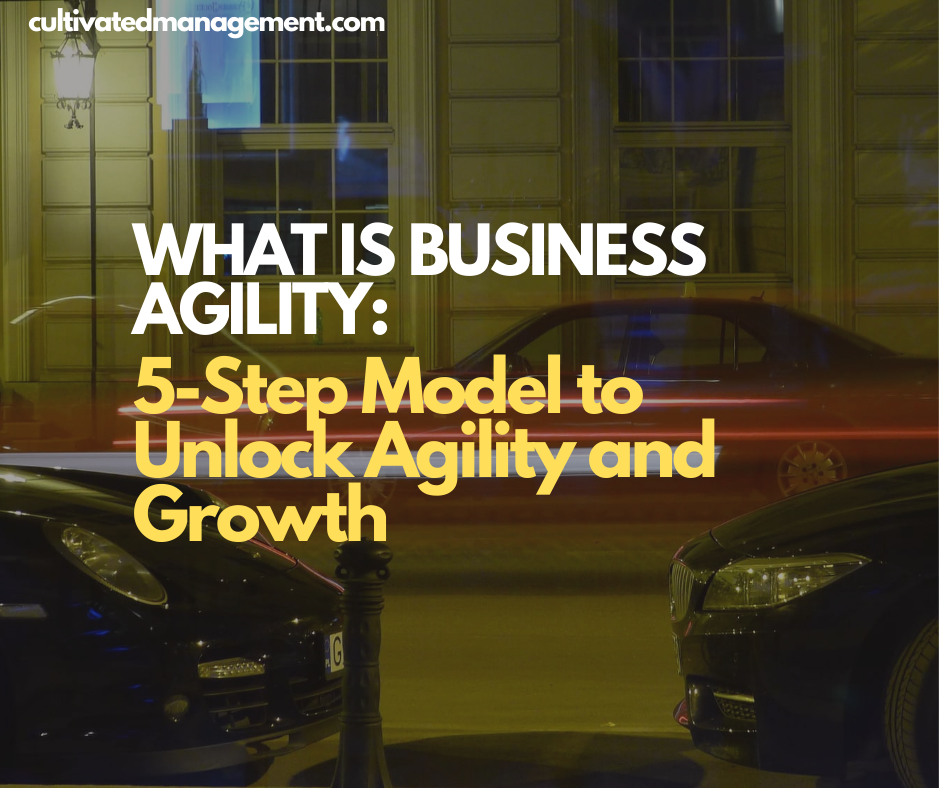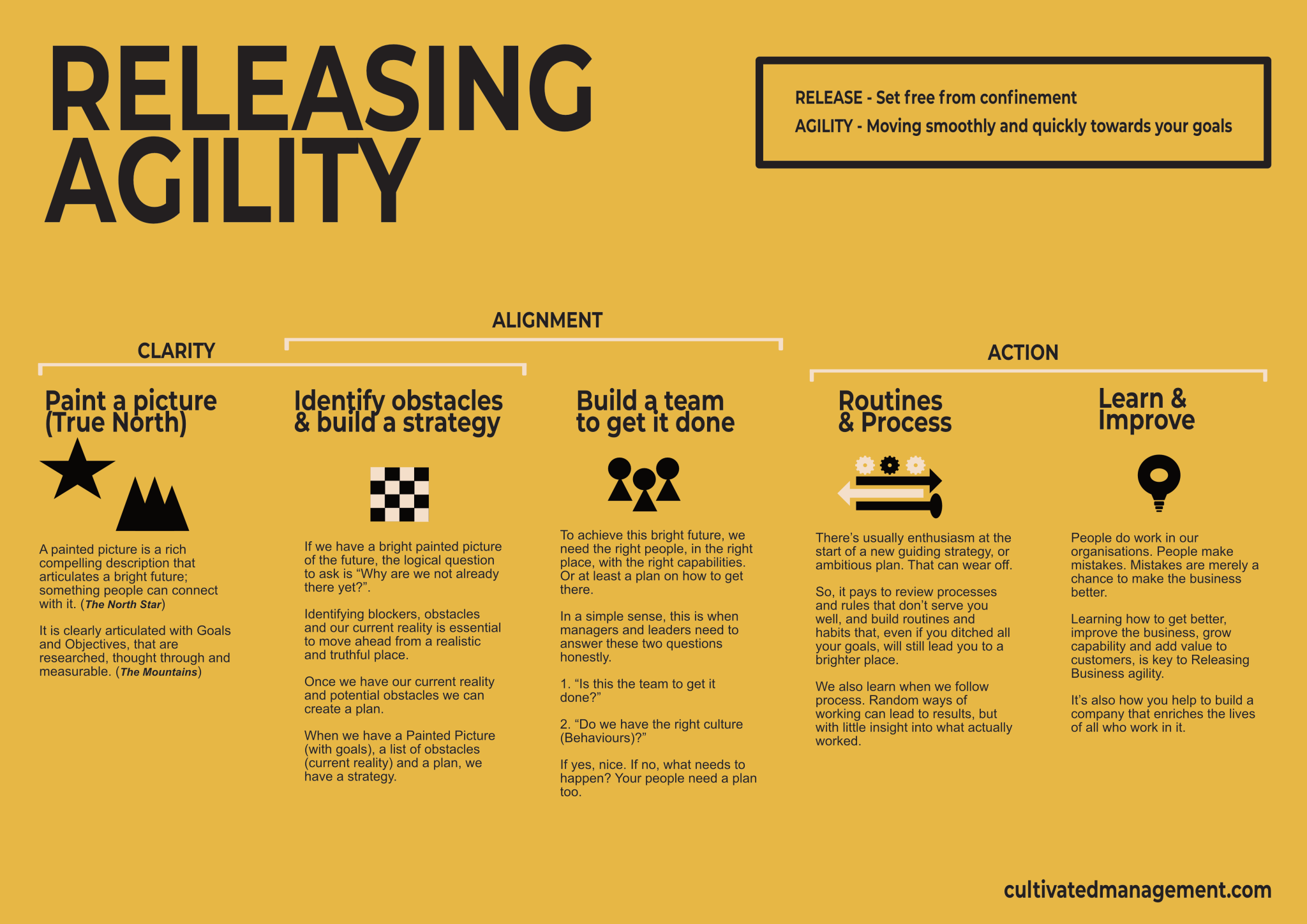
Business agility isn’t a buzzword — it’s a journey. For over a decade, I’ve helped leaders and managers release agility in their organisations: moving smoothly and quickly toward ambitious goals while cultivating workplaces that enrich everyone involved.
In this article, I’ll explain what business agility is, who owns it, and how to release it. Along the way, I’ll link to practical resources from across the Cultivated Management site on strategy, people management, and problem solving.
What is Business Agility?
Business agility is the ability to move smoothly and quickly toward your goals while keeping your organisation healthy, engaging, and inspiring for the people in it.
It’s not a quick fix, and it’s never truly “done.” There will always be problems to solve, processes to optimise, and new ways to improve. That’s why I call it Releasing Agility: a continuous journey of removing obstacles and accelerating toward a bright future.
It’s about balance:
- Moving toward an ambitious future and achieving business goals, and
- Creating a company that’s a joy to work in, where people feel valued and energised.
Breaking Down the Terms
Agility – the ability to move quickly and smoothly toward your goals.
Release – to free something from constraints.
Every business starts agile at some point. Then, red tape, politics, and outdated practices slow things down. Releasing agility means identifying these obstacles and removing them.
The Releasing Agility Model
The model is not a framework or prescriptive playbook. It’s a thinking tool designed to:
- Encourage study, observation, and insight
- Foster problem solving and creativity
- Align solutions with your business’s unique context, culture, and goals
It’s a lens — a checklist — of five key areas to explore, study, and act on.

Business Agility Belongs to Leaders
Most obstacles slowing growth were created by well-meaning leaders and managers. Therefore, leaders and managers must own the solutions.
Most business problems stopping growth and delivery are systemic, and solving them requires authority and insight. Hence, this is the realms of leaders and managers.
The key levers for releasing agility are: clarity, alignment, and right action. Busy work misaligned to goals is a trap; the right work is what adds value and moves the business toward its bright future.
The 5 Thinking Steps of Releasing Agility
Each step is designed to make leaders think, observe, and study before acting.
Step 1 – Paint a Picture of the Future
Clarity is everything. Leaders must articulate a bright, emotionally compelling future. This isn’t strategy — it’s the foundation of it. Goals should align with creating an ambitious, inspiring company, not just product deliverables.
Ask yourself:
- What direction is the company heading in?
- Is the future story clear and compelling?
- Are people aligned and energised around this vision?
Resources: How to Paint a Picture of the Future | Business Storytelling
Step 2 – Identify Obstacles
Next, confront reality. Ask:
"If this future is so compelling, what’s stopping us from achieving it tomorrow?"
Honest reflection is tough but necessary here. Many obstacles are systemic and were created by leaders themselves – so it often takes a self reflecting leader to own up to being part of the problem. Focus on the problems that block your bright future, not the noise.
Document obstacles, study them, and create a plan with names, deadlines, paths, and expected results.
Once you have a bright compelling future with goals, and you have a list of obstacles – and a plan to overcome them – you essentially have a strategy.
Resources: Creative Problem Solving | Building a Strategy
Step 3 – Build the Team
No one achieves a bright future alone. Leaders must assemble the right team, with the skills and motivation to tackle obstacles.
Ask:
- Do we have the people to get this done?
- How can we address low performance or skill gaps?
- What behaviours do we need to encourage?
- In other words – looking around your business – ask "Is this the team to get it done?"
The team is the engine of success. Build it thoughtfully.
Resources: Step 3 Deep Dive | Communication Skills & Storytelling Workshops
Step 4 – Define Habits and Routines
Success comes from optimised processes and daily habits. Good routines free mental space for creativity, problem solving, and adding value.
Key points:
- Standardise only what needs standardising
- Optimise continuously
- Double down on what works, fix what doesn’t
- Create space for creativity and complex work
Resources: Habits & Routines for Success
Step 5 – Iterate, Learn, and Improve
No plan survives unchanged. Problems arise that you may never anticipate. A learning culture is essential:
- Leaders must model humility and curiosity
- Mistakes are a rich source of insight
- Learning initiatives must shift behaviours, not just add training hours
Resources: Mistakes are an opportunity to get better | Build a Learning Culture | Personal Knowledge Management | A3 Thinking for Root Cause Analysis
How to Measure Agility
Forget spider diagrams and maturity models. Measure what matters:
- Business Results: Costs, revenue, margin, retention, market share — trending improvements matter more than one-off numbers.
- Customer Outcomes: Satisfaction, churn, support calls. Are you delivering value consistently?
- People & Culture: Engagement, morale, and development. Look at behaviours, not just numbers.
- Flow Metrics: Velocity, throughput, work in process, cycle time. Smooth delivery beats full-capacity chaos.
- Failure Demand: How much work corrects mistakes instead of adding value? Reducing this frees time for meaningful work.
Two Persistent Norms to Challenge
Don’t pass the burden. Leaders must own systemic problems instead of offloading them.
Don’t push blindly. Pushing people harder without solving root problems creates dysfunction. Focus on removing obstacles, not forcing more effort.
Releasing agility is about:
- Clarifying the vision
- Removing blockers
- Ensuring the team is ready
- Optimising routines
- Learning continuously
The results? Better business outcomes, engaged people, and a workplace that feels alive and inspiring.
Business agility is a never-ending journey. Done right, it’s energising, enriching, and deeply satisfying. Releasing agility means solving real problems, aligning people, and creating a future worth moving toward.
